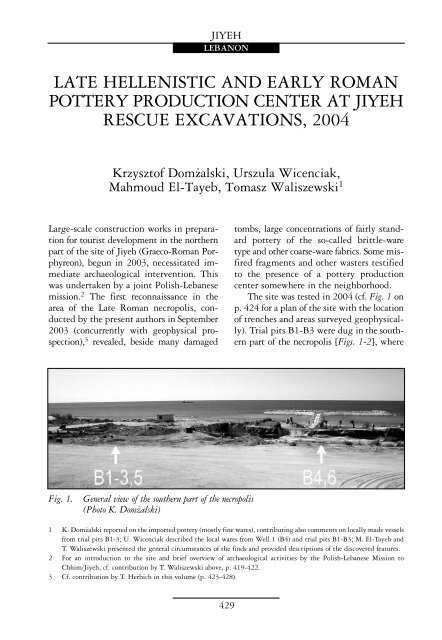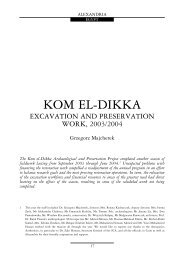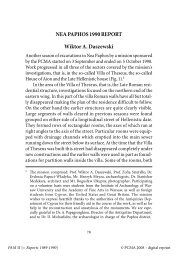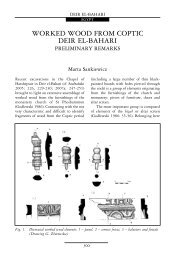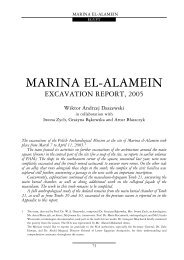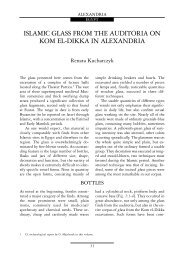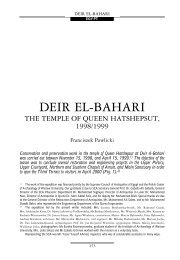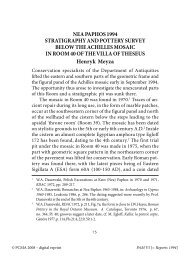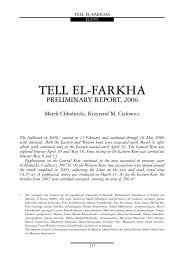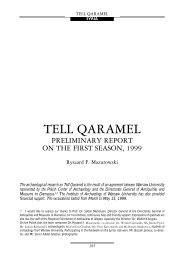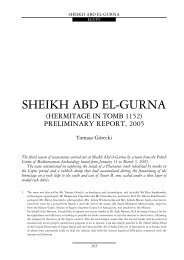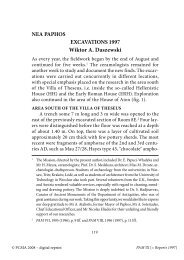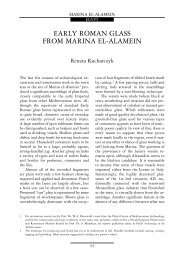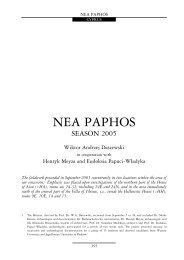late hellenistic and early roman pottery production center at jiyeh ...
late hellenistic and early roman pottery production center at jiyeh ...
late hellenistic and early roman pottery production center at jiyeh ...
Create successful ePaper yourself
Turn your PDF publications into a flip-book with our unique Google optimized e-Paper software.
JIYEH<br />
LEBANON<br />
LATE HELLENISTIC AND EARLY ROMAN<br />
POTTERY PRODUCTION CENTER AT JIYEH<br />
RESCUE EXCAVATIONS, 2004<br />
Krzysztof Dom¿alski, Urszula Wicenciak,<br />
Mahmoud El-Tayeb, Tomasz Waliszewski 1<br />
Large-scale construction works in prepar<strong>at</strong>ion<br />
for tourist development in the northern<br />
part of the site of Jiyeh (Graeco-Roman Porphyreon),<br />
begun in 2003, necessit<strong>at</strong>ed immedi<strong>at</strong>e<br />
archaeological intervention. This<br />
was undertaken by a joint Polish-Lebanese<br />
mission. 2 The first reconnaissance in the<br />
area of the L<strong>at</strong>e Roman necropolis, conducted<br />
by the present authors in September<br />
2003 (concurrently with geophysical prospection),<br />
3 revealed, beside many damaged<br />
tombs, large concentr<strong>at</strong>ions of fairly st<strong>and</strong>ard<br />
<strong>pottery</strong> of the so-called brittle-ware<br />
type <strong>and</strong> other coarse-ware fabrics. Some misfired<br />
fragments <strong>and</strong> other wasters testified<br />
to the presence of a <strong>pottery</strong> <strong>production</strong><br />
<strong>center</strong> somewhere in the neighborhood.<br />
The site was tested in 2004 (cf. Fig. 1 on<br />
p. 424 for a plan of the site with the loc<strong>at</strong>ion<br />
of trenches <strong>and</strong> areas surveyed geophysically).<br />
Trial pits B1-B3 were dug in the southern<br />
part of the necropolis [Figs. 1-2], where<br />
Fig. 1.<br />
General view of the southern part of the necropolis<br />
(Photo K. Dom¿alski)<br />
1 K. Dom¿alski reported on the imported <strong>pottery</strong> (mostly fine wares), contributing also comments on locally made vessels<br />
from trial pits B1-3; U. Wicenciak described the local wares from Well 1 (B4) <strong>and</strong> trial pits B1-B3; M. El-Tayeb <strong>and</strong><br />
T. Waliszewski presented the general circumstances of the finds <strong>and</strong> provided descriptions of the discovered fe<strong>at</strong>ures.<br />
2 For an introduction to the site <strong>and</strong> brief overview of archaeological activities by the Polish-Lebanese Mission to<br />
Chhim/Jiyeh, cf. contribution by T. Waliszewski above, p. 419-422.<br />
3 Cf. contribution by T. Herbich in this volume (p. 423-428).<br />
429
JIYEH<br />
LEBANON<br />
concentr<strong>at</strong>ions of <strong>pottery</strong> sherds were the<br />
densest <strong>and</strong> traces of burning <strong>and</strong> ash were<br />
noted. A well (B4) full of <strong>pottery</strong> fragments,<br />
including more or less complete vessels, was<br />
uncovered during bulldozing work c. 60 m<br />
to the northwest of the first trial pits [Fig. 3].<br />
Further in the same sector brought to light<br />
a nondescript rectangular structure made<br />
of s<strong>and</strong>stone blocks (B5), as well as another<br />
well <strong>and</strong> nearby basin (B6). These were<br />
cleaned <strong>and</strong> recorded, but their precise<br />
function could not be determined.<br />
Fig. 2.<br />
Trial pits B1-B3 in the first days of excav<strong>at</strong>ions<br />
(Photo K. Dom¿alski)<br />
Fig. 3.<br />
Well 1 (B4) with a mound of non-diagnostic sherds from the excav<strong>at</strong>ed fill seen in the foreground<br />
(Photo K. Dom¿alski)<br />
430
JIYEH<br />
LEBANON<br />
TRIAL PITS B1-B3<br />
The main trial pit (B1), measuring 12 by 4 m,<br />
bisected an ambiguous rounded fe<strong>at</strong>ure,<br />
which was suspected to represent the remains<br />
of a destroyed <strong>pottery</strong> kiln. Unfortun<strong>at</strong>ely,<br />
explor<strong>at</strong>ion of the gray spot containing<br />
traces of burning <strong>and</strong> ashes, c. 5-6 m<br />
in diameter, ended quickly as no structural<br />
element was found. The large <strong>pottery</strong> dump<br />
noted nearby in the northern trench wall<br />
was explored after enlarging the trench 2 m<br />
to the north [Fig. 4]. Trial pits B2-B3<br />
were of slightly smaller dimensions <strong>and</strong><br />
were loc<strong>at</strong>ed about 15-20 m to the south of<br />
B1. Traces of burning accompanied the<br />
abundant <strong>pottery</strong> finds from this area. In<br />
all trenches (B1-B3), sterile soil was reached,<br />
revealing the homogeneous n<strong>at</strong>ure<br />
of the str<strong>at</strong>igraphy <strong>and</strong> m<strong>at</strong>erial across the<br />
area.<br />
The coarse <strong>pottery</strong> assemblage comprised<br />
vessels of various form <strong>and</strong> size – cooking<br />
pots, transport amphorae, pot st<strong>and</strong>s, lids,<br />
jugs, bowls, dishes <strong>and</strong> pans – strongly domin<strong>at</strong>ed,<br />
however, by two forms of cooking<br />
pots (see below). Other forms were represented<br />
less numerously. Wasters were in evidence.<br />
Single examples of local imit<strong>at</strong>ions<br />
of some imported fine ware vessels <strong>and</strong> oil<br />
lamps were found in all the trenches.<br />
A sprinkling of imported fine ware<br />
fragments (see below), regularly distributed<br />
through all the trenches <strong>and</strong> layers, indic<strong>at</strong>ed<br />
th<strong>at</strong> the <strong>pottery</strong> dumps had accumu<strong>l<strong>at</strong>e</strong>d<br />
in the course of the 2nd century BC.<br />
A comparison of coarse ware forms from<br />
the dumps with parallels from other sites<br />
in the region (mainly Beirut) confirmed<br />
the d<strong>at</strong>ing.<br />
Fig. 4.<br />
Pottery dump in trial pit B1, visible north trench wall with a section through the dump<br />
(Photo K. Dom¿alski)<br />
431
JIYEH<br />
LEBANON<br />
LOCALLY PRODUCED POTTERY FROM TRIAL PITS B1-B3<br />
The huge quantities of strongly fragmented<br />
sherds of brittle-ware <strong>and</strong> other coarse<br />
vessels, including many misfired pieces,<br />
proved th<strong>at</strong> the following forms: cooking<br />
pots, pot st<strong>and</strong>s, fl<strong>at</strong>-based bowls <strong>and</strong><br />
dishes, jugs, lids, transport amphorae <strong>and</strong><br />
oil lamps, must have been manufactured in<br />
nearby workshops. The fabric was r<strong>at</strong>her<br />
similar in all cases, granular <strong>and</strong> rough in<br />
the break, <strong>and</strong> r<strong>at</strong>her gritty on the surface.<br />
The color depended on firing conditions<br />
<strong>and</strong> went from grayish, greenish <strong>and</strong><br />
brownish to reddish <strong>and</strong> orange. Most of<br />
the wasters represented deformed vessels;<br />
the amorphous fired clay blocks were of<br />
greenish hue.<br />
Two types of cooking pots prevailed in<br />
the assemblage: a globular pot with collartype<br />
vertical rim [Fig. 5] <strong>and</strong> one with an<br />
outward-slanting rim. Fragments of the<br />
first form were the most numerous. Pot<br />
st<strong>and</strong>s, fl<strong>at</strong>- based bowls <strong>and</strong> dishes, jugs<br />
<strong>and</strong> lids were of fairly similar shape, differing<br />
in size alone. Interestingly, almost<br />
all of the lids had h<strong>and</strong>les intentionally<br />
pierced with a pointed tool.<br />
Fig. 5. Locally made cooking pot fragments from<br />
trial pits B1-B3 (Photo K. Dom¿alski)<br />
Fig. 6.<br />
Locally made transport amphorae fragments from trial pits B1-B3; note wasters on the right<br />
(Photo K. Dom¿alski)<br />
432
JIYEH<br />
LEBANON<br />
Several forms of amphorae could be distinguished,<br />
differing in rim profiles, h<strong>and</strong>les<br />
<strong>and</strong> bases [Fig. 6]. They were generally unstamped,<br />
as only two stamps on h<strong>and</strong>les<br />
were found among several hundred unstamped<br />
ones. Moreover, some complete loomweights<br />
<strong>and</strong> fragments of braziers of different<br />
types were found. It is unclear, whether<br />
they were also locally made as not many were<br />
found <strong>and</strong> there were no misfired examples<br />
among them.<br />
Single fragments of unfinished <strong>and</strong> deformed,<br />
r<strong>at</strong>her thin-walled vessels of tableware<br />
type, such as bowls <strong>and</strong> oil lamps, led<br />
to the assumption th<strong>at</strong> a small series of finer<br />
<strong>pottery</strong> made in the typical brittle ware<br />
fabric was also produced by the local potters.<br />
The most evident case is th<strong>at</strong> of a w<strong>at</strong>chshaped<br />
oil lamp with unpierced nozzle<br />
[Fig. 7]. Furthermore, several pieces of jugs<br />
<strong>and</strong> unguentaria, as well as of a terracotta<br />
figurine were collected.<br />
IMPORTED POTTERY FROM B1-B3<br />
Most frequent among the generally scarce<br />
imported fine ceramics are fragments resembling<br />
the so-called Hellenistic Color-co<strong>at</strong>ed<br />
Ware A group, possibly of southeastern<br />
Aegean origin, 4 characterized by mostly uniform<br />
red slip, as well as black-gloss ware<br />
from some Asia Minor <strong>and</strong> possibly Italian<br />
(Campanian) <strong>center</strong>s. Moreover, a single sherd<br />
of Eastern Sigill<strong>at</strong>a A (ESA) 5 origin<strong>at</strong>ing<br />
from the region of Antioch was recorded.<br />
The first group was represented by undecor<strong>at</strong>ed<br />
bowls with incurved rims, p<strong>l<strong>at</strong>e</strong>s<br />
Fig. 7.<br />
Imported (above) <strong>and</strong> locally made (below) oil lamps from trial pits B1-B3; note the lamp with<br />
unpierced nozzle in the bottom left corner (Photo K. Dom¿alski)<br />
4 Cf. J.W. Hayes, The Hellenistic <strong>and</strong> Roman Pottery, Paphos III (Nicosia 1991), 23-24, Fig. XII:1-3.<br />
5 J.W. Hayes, "Sigil<strong>l<strong>at</strong>e</strong> orientali", in: Ceramica fine <strong>roman</strong>a nel bacino mediterraneo (tardo ellenismo e primo imperio),<br />
Atlante delle forme ceramiche II, Enciclopedia dell'Arte antica, classica e orientale (Roma 1985), 9-48, Pls. I-XI.<br />
433
JIYEH<br />
LEBANON<br />
(including fish-p<strong>l<strong>at</strong>e</strong>s) <strong>and</strong> the most characteristic,<br />
conical-bodied bowls or skyphoi<br />
with pinched loop h<strong>and</strong>les. Black-gloss vessels,<br />
bowls <strong>and</strong> p<strong>l<strong>at</strong>e</strong>s, were decor<strong>at</strong>ed with<br />
stamped palmettae <strong>and</strong> rouletted b<strong>and</strong>s.<br />
The ESA fragment is a large variant of bowl<br />
with incurved rim, form 20, with stamped<br />
palmettae. The repertoire of forms <strong>and</strong> the<br />
quality of these vessels place them in the<br />
2nd century BC. Importantly, no single<br />
pieces of ESA belonging to the st<strong>and</strong>ard<br />
L<strong>at</strong>e Hellenistic "service" (p<strong>l<strong>at</strong>e</strong>s, forms 3-<br />
WELL 1 (B4)<br />
4; bowl, form 22) from the 1st century BC<br />
were found in the examined deposits.<br />
Imported <strong>pottery</strong> comprised also one<br />
completely preserved <strong>and</strong> several fragmented<br />
w<strong>at</strong>ch-shaped, turned oil lamps <strong>and</strong><br />
a single fragment of mould-made lamp<br />
[cf. Fig. 7]. Additionally, three h<strong>and</strong>les<br />
of Rhodian trade amphorae (two stamped)<br />
were recorded, as well as one mould-made<br />
brazier pot support decor<strong>at</strong>ed with a bearded<br />
head. All these finds conform to the d<strong>at</strong>ing<br />
of the fine <strong>pottery</strong>.<br />
The accidentally discovered well was horseshoe-shaped,<br />
the upper section measuring<br />
1.30 by 1.10 m, the base 1.60 by 1.30 m.<br />
The upper part of the well was built of<br />
s<strong>and</strong>stone blocks to a depth of 2.40 m. The<br />
lower part was cut in the s<strong>and</strong>stone, reaching<br />
a maximum depth of about 7 m.<br />
The well was filled with <strong>pottery</strong> sherds. The<br />
upper part of the filling contained mainly<br />
large fragments of amphorae with little<br />
interspersed earth <strong>and</strong> s<strong>and</strong>. The lower layers<br />
revealed sherds <strong>and</strong> some better preserved<br />
vessels of other forms mixed with earth,<br />
s<strong>and</strong>, mud <strong>and</strong> gray soil. This filling<br />
continued to the very bottom of the well.<br />
The huge amount of <strong>pottery</strong> m<strong>at</strong>erial<br />
found in the well is estim<strong>at</strong>ed <strong>at</strong> about<br />
10.35 cubic meters [cf. Fig. 3]. The diversity<br />
of st<strong>and</strong>ardized vessel forms merits interest.<br />
The assemblage contained amphorae,<br />
cooking pots, jugs, bowls, dishes, pans,<br />
<strong>and</strong> pot-st<strong>and</strong>s (cf. below). It included many<br />
diagnostic fragments <strong>and</strong> some misfired<br />
pieces, but almost complete vessels were<br />
also unearthed.<br />
The well may have been dug to provide<br />
w<strong>at</strong>er for a <strong>pottery</strong> workshop oper<strong>at</strong>ing nearby.<br />
For one reason or another, it was used<br />
thereafter as a dump for ceramic <strong>production</strong><br />
wasters. It is important to note th<strong>at</strong><br />
besides the locally-made ceramics, no<br />
other rubbish of the usual kind was ever<br />
thrown into it, apart from a very limited<br />
number of imported fine ware fragments<br />
(cf. below), bricks, shells <strong>and</strong> bones of<br />
some small species of animals.<br />
LOCALLY PRODUCED POTTERY FROM WELL 1 (B4)<br />
Down to a depth of about 2 m, the<br />
ceramic assemblage was domin<strong>at</strong>ed by<br />
amphora sherds. Altogether six forms were<br />
distinguished, including three forms<br />
represented by a single example each. The<br />
most frequent containers, form 1 [Figs. 8-<br />
9] are characterized by a brown-reddish<br />
fabric with light gray core, medium<br />
texture <strong>and</strong> hardness, a gre<strong>at</strong> deal of very<br />
small <strong>and</strong> a few large white lime grains, as<br />
well as some black grains <strong>and</strong> quartz. They<br />
have r<strong>at</strong>her thin walls with a ribbed profile.<br />
Their most characteristic fe<strong>at</strong>ures are<br />
th<strong>at</strong> they are of medium-length, have<br />
a broad neck, plain down-turned rim, <strong>and</strong><br />
a conical-pointed base. Fragments of this<br />
form included many over-fired <strong>and</strong> deformed<br />
pieces. Interestingly, the finds from<br />
434
JIYEH<br />
LEBANON<br />
Jiyeh are similar in form <strong>and</strong> fabric to the<br />
m<strong>at</strong>erial from Beirut, 6 especially the<br />
amphorae produced in Beirut in the mid<br />
1st century AD. However, unlike the Beirut<br />
ones, 7 the amphorae from Well 1 (B4) bear<br />
no potters' marks.<br />
Below the third meter, there appeared<br />
another form of amphorae, as well as several<br />
forms of utility vessels, such as cooking<br />
pots, casseroles, pans, jugs, juglets, bowls<br />
<strong>and</strong> pot-st<strong>and</strong>s. Some of these forms were<br />
represented by only a few sherds, including<br />
over-fired ones. N<strong>early</strong> all of the mentioned<br />
vessels have distinctive subtypes, especially<br />
recognizable by their rims <strong>and</strong> necks.<br />
The prevailing kitchen ware vessels included<br />
cooking pots <strong>and</strong> casseroles with sagging<br />
or fl<strong>at</strong> bases, 8 among which four main<br />
variants could be distinguished. The Beirut<br />
analogies d<strong>at</strong>e the majority of these vessels<br />
tent<strong>at</strong>ively to the mid-1st century AD. 9<br />
Fig. 8. Locally made amphora form 1<br />
(Photo M. Kisielewicz, drawing U. Wicenciak)<br />
6 Mr. Abdallah Ala'eddine kindly consulted this m<strong>at</strong>erial.<br />
7 P. Reynolds, "Amphorae in Roman Lebanon 50 BC to AD 250", Archaeology <strong>and</strong> History in Lebanon, Spring 2003,<br />
120-131.<br />
8 Cf. C. Aubert, "Les céramiques hellénistiques de Beyrouth. Caractéristiques des <strong>production</strong>s locales", in: F. Blondé,<br />
P. Ballet, J.-F. Salles (eds.), Céramiques hellénistiques et romaines. Productions et diffusion en Méditerranée orientale<br />
(Chypre, Égypte et côte syro-palestinienne) (Lyon 2002), 73-84.<br />
9 Cf. A. Berlin, The Hellenistic <strong>and</strong> Roman Pottery: The Plain Wares, Tell Anafa II:1 (Ann Arbor 1997), Pl. 24:PW208.<br />
435
JIYEH<br />
LEBANON<br />
Fig. 9.<br />
Locally made transport amphorae fragments from Well 1 (B4)<br />
(Photo K. Dom¿alski (top), M. Kisielewicz)<br />
436
JIYEH<br />
LEBANON<br />
The third group (after amphorae <strong>and</strong><br />
cooking pots) strongly represented in the<br />
assemblage, in quantity as well as variety,<br />
are the bowls. Some variants could be identified,<br />
including the ones (less frequently<br />
encountered) characterized by a fl<strong>at</strong> rim<br />
<strong>and</strong> base, <strong>and</strong> diameter up to 0.40 m, as<br />
well as another variant with a grooved rim.<br />
Other fragments represented imit<strong>at</strong>ions<br />
of Italian-type orlo bifido pans. 10 Moreover,<br />
large numbers of dishes with fl<strong>at</strong>, deeply<br />
grooved rim were found, some of them decor<strong>at</strong>ed<br />
on the outer edge of the rim with<br />
impressed twisted rope-like p<strong>at</strong>terns. The<br />
last form collected in rel<strong>at</strong>ively large quantities<br />
are the pot st<strong>and</strong>s. Their homogenous<br />
fabric could also indic<strong>at</strong>e their local origin.<br />
Finally, jugs made up a small but varied<br />
group with a few virtually complete items.<br />
The rich diversity of st<strong>and</strong>ardized vessel<br />
forms in this sealed deposit is noteworthy.<br />
Almost all the fragments bear no sign of<br />
daily use, which means th<strong>at</strong> they were rejected<br />
during or right after manufacture.<br />
IMPORTED POTTERY FROM WELL 1 (B4)<br />
Very few sherds of imported fine-ware<br />
vessels were found among the masses of<br />
coarse <strong>pottery</strong>. They embraced some small<br />
<strong>and</strong> worn fragments of bowls <strong>and</strong> p<strong>l<strong>at</strong>e</strong>s of<br />
black-gloss ware Estern Sigill<strong>at</strong>a A (ESA) 11<br />
forms 3-4, as well as so-called Cypriot Sigill<strong>at</strong>a<br />
(CS) form 22A. 12 All these <strong>early</strong> pieces<br />
can be d<strong>at</strong>ed to the 1st century BC <strong>and</strong> the<br />
beginning of the 1st century AD. Bigger<br />
<strong>and</strong> best represented fragments, much less<br />
worn, belong to ESA p<strong>l<strong>at</strong>e</strong>s, forms 35 <strong>and</strong><br />
37, as well as bowls, forms 46-47, including<br />
a base of a bowl fe<strong>at</strong>uring a rectangular<br />
XAPIC stamp. They d<strong>at</strong>ed the termin<strong>at</strong>ion<br />
of the well deposit to no earlier than<br />
the <strong>l<strong>at</strong>e</strong> 1st century AD. Additionally, some<br />
single fragments of mould-made Roman<br />
lamps <strong>and</strong> amphorae from North Africa<br />
(probably Tunisia or Libya) were identified<br />
among the finds.<br />
RECTANGULAR STONE STRUCTURE (B5)<br />
A rectangular structure (B5) situ<strong>at</strong>ed about<br />
50 m to the west of trial pits B1-B3 was<br />
brought to light during bulldozer work.<br />
The fe<strong>at</strong>ure measured c. 8 by 6 m <strong>and</strong> had<br />
walls preserved up to a heigh two courses<br />
of big s<strong>and</strong>stone blocks. Its general<br />
appearance gave the impression of a sort of<br />
pl<strong>at</strong>form r<strong>at</strong>her than chamber. The earth<br />
WELL 2 AND BASIN (B 6)<br />
around the walls was compact, containing<br />
numerous potsherds, charcoal <strong>and</strong> other<br />
organic m<strong>at</strong>erial. The charcoal, recorded in<br />
the northern <strong>and</strong> eastern str<strong>at</strong>igraphic crosssections,<br />
evidenced long-term burning<br />
processes. As it was not possible to explore<br />
this fe<strong>at</strong>ure thoroughly, its function<br />
remains unknown.<br />
Another well was found c. 10 m to the<br />
southwest of the above described one (well<br />
1, B4) [Fig. 10]. Its upper part, built of regular<br />
s<strong>and</strong>stone blocks, had been damaged<br />
by bulldozer. The well was excav<strong>at</strong>ed to<br />
a depth of only about 4 m below the sur-<br />
10 Cf. Hayes, Hellenistic <strong>and</strong> Roman…, op. cit., Fig. XXVII:8,9.<br />
11 Cf. note 5 above.<br />
12 Hayes, "Sigil<strong>l<strong>at</strong>e</strong> orientali…", op. cit., 79-91, Pls. XVIII-XXII.<br />
437
JIYEH<br />
LEBANON<br />
face. It was oval in shape with the biggest<br />
diameter being c. 2.40 m. For technical<br />
reasons it was not possible to explore it to<br />
the very bottom, <strong>and</strong> the explored part was<br />
full of very fine white sea s<strong>and</strong> absolutely<br />
devoid of any artifacts.<br />
Remains of wh<strong>at</strong> seems to be a basin<br />
associ<strong>at</strong>ed with Well 2 were discovered to<br />
the west of it [cf. Fig. 10]. Parts of the east<br />
<strong>and</strong> south walls of the basin were excav<strong>at</strong>ed,<br />
the rest remaining concealed under<br />
a provisional modern road. The basin may<br />
have gone out of use when the nearby well<br />
dried up. Afterwards, it quickly filled with<br />
earth including potsherds, charcoal, glass<br />
<strong>and</strong> organic m<strong>at</strong>erials. Altogether nine layers<br />
were recorded.<br />
Once the basin was filled, some other<br />
structure was erected on the same spot. Remnants<br />
of a gravel-<strong>and</strong>-lime floor are suggestive<br />
of a chamber measuring 4.28 by<br />
2 m. Of gre<strong>at</strong> interest is the layer bene<strong>at</strong>h<br />
the room surface, about 0.10-0.15 m thick<br />
<strong>and</strong> consisting of pure white sea s<strong>and</strong>. The<br />
sea level must have been higher <strong>at</strong> one<br />
point, allowing s<strong>and</strong> to accumu<strong>l<strong>at</strong>e</strong> over<br />
the last ancient occup<strong>at</strong>ion layer d<strong>at</strong>ed to<br />
the Hellenistic period. Therefore, Well 2<br />
could also d<strong>at</strong>e from th<strong>at</strong> time, as it had<br />
been filled with the same type of s<strong>and</strong>.<br />
Fig. 10. Well 2 <strong>and</strong> basin (B6) seen from the south-east<br />
(Photo M. El-Tayeb)<br />
438
JIYEH<br />
LEBANON<br />
CONCLUSIONS<br />
The ample ceramic m<strong>at</strong>erial with many<br />
wasters provides good evidence for a longlasting<br />
tradition of <strong>pottery</strong> manufacture <strong>at</strong><br />
Jiyeh, a tradition embracing the years <strong>at</strong><br />
least from the 2nd century BC to the <strong>l<strong>at</strong>e</strong><br />
1st century AD or even slightly <strong>l<strong>at</strong>e</strong>r.<br />
Unfortun<strong>at</strong>ely, no remains th<strong>at</strong> could be<br />
re<strong>l<strong>at</strong>e</strong>d to workshop infrastructure, such as<br />
<strong>pottery</strong> kilns, were found in the area<br />
destroyed by modern construction works.<br />
However, one should bear in mind th<strong>at</strong> in<br />
<strong>l<strong>at</strong>e</strong>r Roman times the whole territory<br />
began to be used for burial purposes <strong>and</strong><br />
<strong>production</strong> activity must have ceased. It<br />
can only be supposed th<strong>at</strong> the workshops<br />
were ab<strong>and</strong>oned <strong>and</strong> gradually fell into<br />
ruin. The present total devast<strong>at</strong>ion has<br />
made it impossible to record any remains<br />
near the described fe<strong>at</strong>ures. Hopefully, some<br />
traces of the workshops in question may<br />
have survived beyond the boundaries of<br />
the present construction site <strong>and</strong> will be<br />
discovered in the future.<br />
The m<strong>at</strong>erial presented here offers a good<br />
opportunity for detailed analysis of locally<br />
manufactured vessels. The studies in progress<br />
now will contribute to an underst<strong>and</strong>ing<br />
of <strong>pottery</strong> distribution p<strong>at</strong>terns on the<br />
Lebanese coast <strong>and</strong> possibly in the<br />
hinterl<strong>and</strong> as well.<br />
439


